

Rohan
FREEDOM OF INFORMATION ACT 1982. Victorian Current Acts [Index] [Table] [Search] [Search this Act] [Notes] [Noteup] [Download] [Help] TABLE OF PROVISIONS Long Title PART I--PRELIMINARY 1.
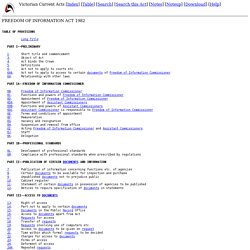
Short title and commencement 3. Object of Act 4. Act binds the Crown 5. HEALTH RECORDS ACT 2001. Victorian Current Acts [Index] [Table] [Search] [Search this Act] [Notes] [Noteup] [Download] [Help] TABLE OF PROVISIONS PART 1--PRELIMINARY 1.

Capability Management. Data Governance. Data Management. Enterprise Information Architecture. Frameworks. General Reading. IM Lifecycle. Information Architecture. Information Management. Information Management Architecture. Information Management Strategy. MIKE2.0 methodology. MIKE2.0 (Method for an Integrated Knowledge Environment) is an open source delivery methodology for Enterprise information management.

MIKE2.0 was released to the public in December, 2006, by BearingPoint, a management and technology consulting company, under the Creative Commons Attribution License. The project is now run by the MIKE2.0 Governance Association ,[1] a non-profit organisation based in Switzerland, with BearingPoint and Deloitte as the founding members. Oracle PeopleSoft Enterprise 8 Sign-in.
VAGO. Victorian Privacy and Data Protection. ESB. Type the email address or phone number of the account you want to sign in with.

We're having trouble locating your account. Which type of account do you want to use? Sign in to {0} Which type of account do you want to sign in with? Be sure to type the password for your work or school account. Try using your email address or phone number. Make sure you typed your email address correctly. VPS Hub. User account. Directory. DPC Yammer. Data.Vic. Data.Vic. The Open Data Handbook. Acts. VicGovAu Thesaurus - The vic.gov.au blog. Version 3, January 2014 Introduction The first edition of the VicGovAu Thesaurus (previously known as the Victoria Online Thesaurus) was developed by Victoria Online and was released in September 2005.
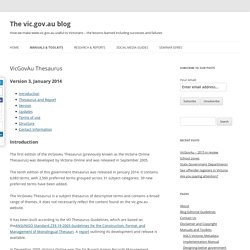
The tenth edition of this government thesaurus was released in January 2014. It contains 6,083 terms, with 2,560 preferred terms grouped across 31 subject categories. 39 new preferred terms have been added. The VicGovAu Thesaurus is a subject thesaurus of descriptive terms and contains a broad range of themes. It has been built according to the VO Thesaurus Guidelines, which are based on theANSI/NISO Standard Z39.19-2003 Guidelines for the Construction, Format, and Management of Monolingual Thesauri. AGIFT Thesaurus. A standard framework for describing the functions of government (AGIFT) The Australian Governments' Interactive Functions Thesaurus (AGIFT) is a three-level hierarchical thesaurus that describes the business functions carried out across Commonwealth, state and local governments in Australia.
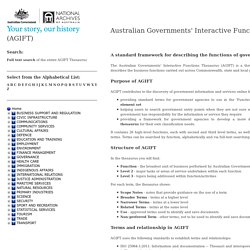
Purpose of AGIFT AGIFT contributes to the discovery of government information and services online by: providing standard terms for government agencies to use in the 'Function' element of the AGLS metadata element set helping users to search government entry points when they are not sure which terms to use or which level of government has responsibility for the information or service they require providing a framework for government agencies to develop a more detailed agency-based functional thesaurus for their own classification needs.
AGLS Metadata Standard - AglsAgent. Namespace: Term URI: HTML/XHTML scheme syntax: AGLSTERMS.AglsAgent XML/RDF scheme syntax: aglsterms:AglsAgent.
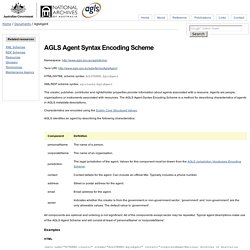
Welcome - data.gov.au. The Government Data Landscape in Australia. The ABS Data Quality Framework. The ABS Data Quality Framework The ABS Data Quality Framework (ABS DQF) provides the standards for assessing and reporting on the quality of statistical information.

It can also assist you with the development of statistical collections to produce high quality outputs. The ABS DQF is based on the Statistics Canada Quality Assurance Framework ( PDF, 178.05 KB) and the European Statistics Code of Practice ( NSS Quality Data Tool. Data Quality Online has been developed by the Australian Bureau of Statistics as an National Statistical Service initiative to help you find information and guidance on the quality management of data.
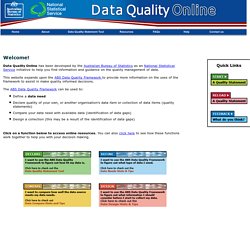
This website expands upon the ABS Data Quality Framework to provide more information on the uses of the framework to assist in make quality informed decisions. The ABS Data Quality Framework can be used to: National Statistical Service § Confidentiality - How to confidentialise data: the basic principles. Identification risks in aggregate dataWhen should a cell be confidentialised?
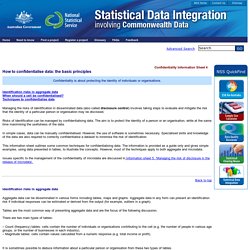
Techniques to confidentialise data Managing the risks of identification in disseminated data (also called disclosure control) involves taking steps to evaluate and mitigate the risk that the identity of a particular person or organisation may be disclosed. Risks of identification can be managed by confidentialising data. The aim is to protect the identity of a person or an organisation, while at the same time maximising the usefulness of the data. In simple cases, data can be manually confidentialised. National Statistical Service § Handbook - Chapter 11. 11. Confidentiality and Privacy - Contents Agencies involved in the collection of data have a responsibility to ensure that procedures are implemented to ensure confidentiality of data and privacy of respondents who provided the data.
The primary goal is to ensure that there is no risk that an individual or organisation is identifiable from the output released by a statistical collection agency. Confidentiality and privacy is usually achieved by ensuring that identifiable information about individuals, households and businesses is not released outside the collection agency, is available inside the agency on needs to know basis only and cannot be derived from released data. About CURF Microdata. What is a CURF? A Confidentialised Unit Record File (CURF) is a file of responses to ABS surveys or censuses that have had specific identifying information about persons and organisations confidentialised. CURFs contain very detailed information for each individual record - a record can be a person, a business, a family, household or a job for example.
Why should public data be online? While some things don't really need a public service announcement, we felt our Public=Online campaign could benefit from one. The majority of grassroots campaigns are about product more than process. Whether they're for electing a specific candidate, instituting universal health care or creating a flat tax they have a well defined goal they're working toward. When your goal is to alter processes and to ensure the accountability of all elected officials, describing your campaign becomes a bit more difficult. Especially when your campaign is being co-created with activists from across the country on a daily basis. I made this public service announcement to quickly show how real-time data helps you make informed decisions and why the Public=Online campaign is so important. If you want additional information you can always go to our about page or watch the campaign launch event we had at Google's DC headquarters. Digital Continuity Plan – National Archives of Australia, Australian Government.
Digital continuity is an approach to keeping and managing digital information to ensure that it can be used in the way that is required for as long as required, and no longer. 1 'Digital continuity ensures information is complete, available and useable by those with a need for it. It also ensures the information is not kept for longer than needed. Information is useable when you can: find it when you need itopen it when you need itwork with it in the way you need tounderstand what it is and what it is about, andtrust that it is what it says it is.' 2 Information is a key component of normal business activity, yet information today is more vulnerable than it ever has been. Decisions that impact digital continuity should be based on an understanding of risks and the costs and the value of the information.
Your agency can use this document and other more detailed advice to formulate and implement a plan to address digital continuity. Data Access Portal - Home Page. AGLS Metadata Standard - Home. DCMI Home: Dublin Core® Metadata Initiative (DCMI) Data Catalog Vocabulary (DCAT) Abstract DCAT is an RDF vocabulary designed to facilitate interoperability between data catalogs published on the Web. This document defines the schema and provides examples for its use. By using DCAT to describe datasets in data catalogs, publishers increase discoverability and enable applications easily to consume metadata from multiple catalogs. 10.5 Data. Information Management Framework. Www.thegovlab.org.